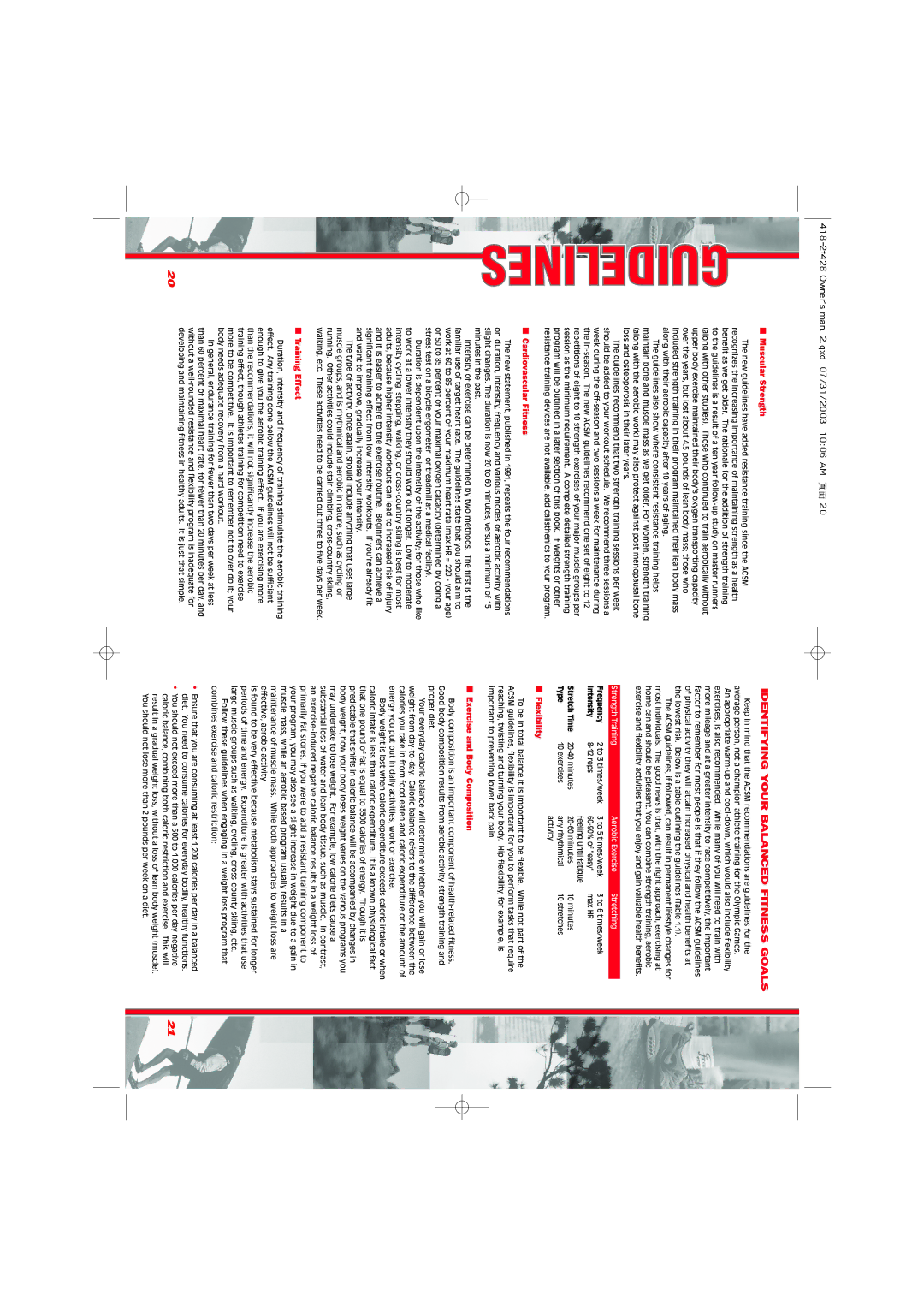
■Muscular Strength
The new guidelines have added resistance training since the ACSM recognizes the increasing importance of maintaining strength as a health benefit as we get older. The rationale for the addition of strength training to the guidelines is a result of a ten year
The guidelines also show where consistent resistance training helps maintain bone and muscle mass as we get older. For women, strength training (along with the aerobic work) may also protect against post menopausal bone loss and osteoporosis in their later years.
The guidelines recommend that two strength training sessions per week should be added to your workout schedule. We recommend three sessions a week during the
■Cardiovascular Fitness
The new statement, published in 1991, repeats the four recommendations on duration, intensity, frequency and various modes of aerobic activity, with slight changes. The duration is now 20 to 60 minutes, versus a minimum of 15 minutes in the past.
Intensity of exercise can be determined by two methods. The first is the familiar use of target heart rate. The guidelines state that you should aim to work at 60 to 85 percent of your maximum heart rate (max HR = 220 - your age) or 50 to 85 percent of your maximal oxygen capacity (determined by doing a stress test on a bicycle ergometer or treadmill at a medical facility).
Duration is dependent upon the intensity of the activity; for those who like to work at a lower intensity they should work out longer. Low to moderate intensity cycling, stepping, walking, or
The type of activity, once again, should include anything that uses large muscle groups, and is rhythmical and aerobic in nature, such as cycling or running. Other activities could include stair climbing,
■Training Effect
Duration, intensity and frequency of training stimulate the aerobic training effect. Any training done below the ACSM guidelines will not be sufficient enough to give you the aerobic training effect. If you are exercising more than the recommendations, it will not significantly increase the aerobic training effect, though athletes training for competition need to exercise more to be competitive. It is important to remember not to over do it; your body needs adequate recovery from a hard workout.
In general, endurance training for fewer than two days per week at less than 60 percent of maximal heart rate, for fewer than 20 minutes per day, and without a
20
IDENTIFYING YOUR BALANCED FITNESS GOALS
Keep in mind that the ACSM recommendations are guidelines for the average person, not a champion athlete training for the Olympic Games.
An appropriate
The ACSM guidelines, if followed, can result in permanent lifestyle changes for most individuals. The good news is that, with the right approach, exercising at home can and should be pleasant. You can combine strength training, aerobic exercise and flexibility activities that you enjoy and gain valuable health benefits.
Strength Training | Aerobic Exercise | Stretching | |
Frequency | 2 to 3 times/week | 3 to 5 times/week | 3 to 6 times/week |
Intensity | max HR | ||
|
| feeling until fatigue |
|
Stretch Time | 10 minutes | ||
Type | 10 exercises | any rhythmical | 10 stretches |
|
| activity |
|
■Flexibility
To be in total balance it is important to be flexible. While not part of the ACSM guidelines, flexibility is important for you to perform tasks that require reaching, twisting and turning your body. Hip flexibility, for example, is important to preventing lower back pain.
■Exercise and Body Composition
Body composition is an important component of
Your everyday caloric balance will determine whether you will gain or lose weight from
Body weight is lost when caloric expenditure exceeds caloric intake or when caloric intake is less than caloric expenditure. It is a known physiological fact that one pound of fat is equal to 3500 calories of energy. Though it is predictable that shifts in caloric balance will be accompanied by changes in body weight, how your body loses weight varies on the various programs you may undertake to lose weight. For example, low calorie diets cause a substantial loss of water and lean body tissue, such as muscle. In contrast, an
is found to be very effective because metabolism stays sustained for longer periods of time and energy. Expenditure is greater with activities that use large muscle groups such as walking, cycling,
Follow these guidelines when engaging in a weight loss program that combines exercise and caloric restriction:
•Ensure that you are consuming at least 1,200 calories per day in a balanced diet. You need to consume calories for everyday bodily, healthy functions.
•You should not exceed more than a 500 to 1,000 calories per day negative caloric balance, combining both caloric restriction and exercise. This will result in a gradual weight loss, without a loss of lean body weight (muscle). You should not lose more than 2 pounds per week on a diet.
21
